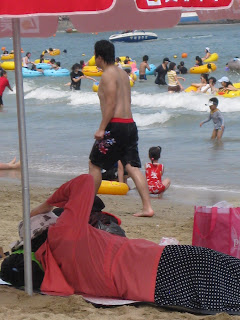The second thing you notice is the autumn colours everywhere. It seemed like every tree was a different shade of red, green or brown - it was very beautiful.

 The hike was definitely much tougher than we all had envisaged. Robyn and Kate were the first to drop out, but the rest of us kept going. Apparently, there are spectacular views along the way, but unfortunately, a heavy fog had rolled in, so we could hardly see a thing! The going was quite good until we actually reached the rock at the top of the mountain. People who were coming down the mountain kept telling us that there were clear views from the very top which motivated us to keep going. The summit can only be reached by climbing about 900 very steep iron steps. Bo Mi and I took a 10 minute breather while the others kept going, started climbing the steps, only to be told by a man coming down the steps that the fog had reached the summit now. It had also started raining, so we decided this was enough reason to head downhill! That was a good idea as the rain made the steps slick. I slid on one of the steep steps and could have hurt myself (only to be grabbed by the man who had just told us about the fog!)
The hike was definitely much tougher than we all had envisaged. Robyn and Kate were the first to drop out, but the rest of us kept going. Apparently, there are spectacular views along the way, but unfortunately, a heavy fog had rolled in, so we could hardly see a thing! The going was quite good until we actually reached the rock at the top of the mountain. People who were coming down the mountain kept telling us that there were clear views from the very top which motivated us to keep going. The summit can only be reached by climbing about 900 very steep iron steps. Bo Mi and I took a 10 minute breather while the others kept going, started climbing the steps, only to be told by a man coming down the steps that the fog had reached the summit now. It had also started raining, so we decided this was enough reason to head downhill! That was a good idea as the rain made the steps slick. I slid on one of the steep steps and could have hurt myself (only to be grabbed by the man who had just told us about the fog!)
Seokcho Beach















 The Fringe Festival ends this Saturday (29th August).
The Fringe Festival ends this Saturday (29th August).


 After looking around the palace buildings, we strolled through Insadong then took the Seoul city bus tour (which managed to cram far too many people onto the bus and thus we could only see things which were on the right hand side of the bus due to all the people standing in the aisle, sigh).
After looking around the palace buildings, we strolled through Insadong then took the Seoul city bus tour (which managed to cram far too many people onto the bus and thus we could only see things which were on the right hand side of the bus due to all the people standing in the aisle, sigh).





 You can also wear all your clothes in the sea!
You can also wear all your clothes in the sea!






 Restaurant
Restaurant

 The blatant disregard for this sign amused me!
The blatant disregard for this sign amused me!


 The south gate through which the spirits were believed to enter and depart (the King would enter from the east gate and the performers would enter through the west gate.
The south gate through which the spirits were believed to enter and depart (the King would enter from the east gate and the performers would enter through the west gate.






